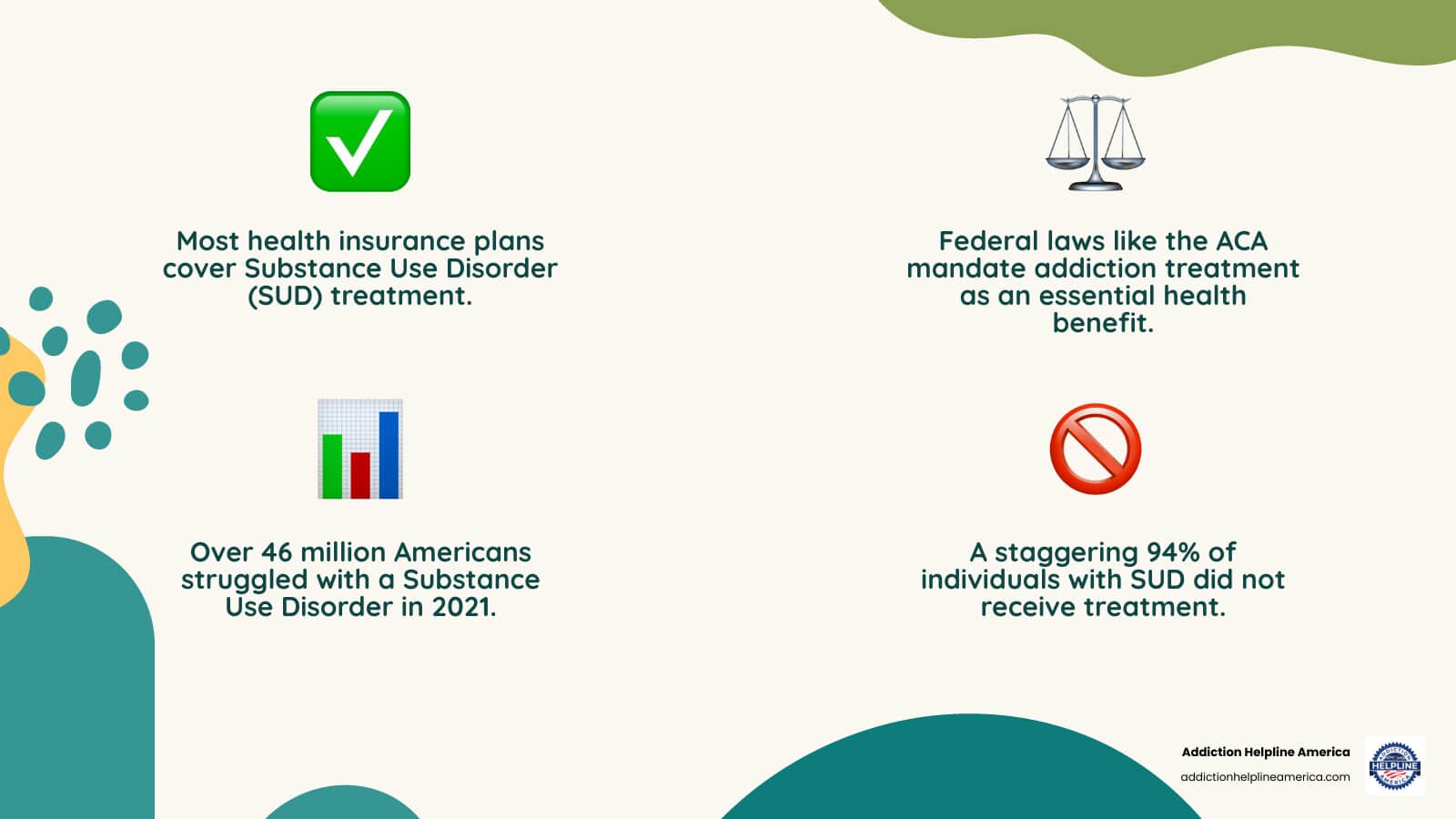Your Journey to a Healthier Life Starts Here
Free Insurance Verification
Verify Your Treatment Coverage
Verify Your Treatment Coverage
Does Insurance Cover Rehab? For anyone seeking help for addiction, this is a crucial question. The good news is that most health insurance plans do cover addiction treatment.
Here’s a quick overview:
The financial burden of treatment can be overwhelming and often stops people from getting care. In 2021, over 46 million Americans had a substance use disorder, but 94% did not get treatment. Understanding your insurance options is a critical first step.
The Affordable Care Act (ACA) was a major change, requiring most health plans to cover addiction services as an essential health benefit. Insurers can no longer deny coverage or charge more for addiction as a pre-existing condition. This guide will help you understand and use your insurance benefits to get the help you or a loved one deserves.
At Addiction Helpline America, we are experts in navigating the complexities of addiction treatment. We’ve helped countless individuals understand whether and how their insurance covers rehab for their specific needs, guiding them toward vital resources and support.

For years, insurance often failed to cover addiction, treating it differently than other medical conditions. Fortunately, federal law is now on your side.
If you’re wondering whether insurance will cover rehab, know that federal laws mandate coverage and protect your right to treatment. These are legal requirements that insurance companies must follow.
The biggest game-changer was the Affordable Care Act (ACA) of 2010. It requires all new small group and individual insurance plans to cover 10 essential health benefits, which include mental health and substance use disorder services. If your plan was created after the ACA took effect, it must include coverage for addiction treatment.
Crucially, the ACA ended the practice of treating addiction as a pre-existing condition. Insurers can no longer deny you coverage or charge higher premiums because you need help, opening the door to recovery for millions.
Another key law is the Mental Health Parity and Addiction Equity Act (MHPAEA) of 2008. This act ensures that insurance companies treat addiction care with the same importance as physical health care.
This means your insurer cannot charge higher copays for therapy than for a doctor’s visit, impose stricter limits on rehab stays than on hospital stays, or create tougher approval processes for addiction treatment. The mental health parity principle requires your addiction treatment to be covered with the same generosity as any physical condition.
These laws provide powerful legal protections for patients. They are the foundation ensuring that when you seek help, your insurance company is required to respond. At Addiction Helpline America, we help people understand these rights and ensure the substance use disorder coverage mandate works for them.

When asking whether insurance will cover rehab, the type of insurance you have—private or public—greatly affects your coverage, access to care, and costs. Let’s break down these categories.
Most Americans have private health insurance, either through an employer or an individual plan from the Health Insurance Marketplace. These plans must cover addiction treatment. Within private insurance, the two most common plan types are HMOs (Health Maintenance Organizations) and PPOs (Preferred Provider Organizations).
HMO plans require you to use a specific network of providers. Your primary care physician (PCP) coordinates your care and must provide a referral for specialists or rehab. While premiums are often lower, there is little to no coverage for out-of-network care.
PPO plans offer more flexibility. You can see specialists without a referral and use out-of-network providers, though at a higher cost. PPOs typically have higher premiums but provide more choice.
Here’s a quick comparison:
| Feature | HMO (Health Maintenance Organization) | PPO (Preferred Provider Organization) |
|---|---|---|
| Network Access | Restricted to providers within the HMO’s network | Can use in-network or out-of-network providers (at higher cost) |
| Referrals | Required from a Primary Care Physician (PCP) for specialists/rehab | Generally not required for specialists/rehab |
| Costs | Lower premiums, lower out-of-pocket for in-network, no/limited out-of-network coverage | Higher premiums, lower out-of-pocket for in-network, higher for out-of-network |
| Flexibility | Less choice of providers | More choice of providers |
To save money, always use in-network providers. They have pre-negotiated rates with your insurer, leading to significantly lower costs for you. Checking if a rehab facility is in your network should be a top priority.
Public health insurance programs like Medicare and Medicaid offer solid options for addiction treatment coverage.
Medicare is a federal program for people 65 or older, as well as younger individuals with certain disabilities. If you’re wondering what Medicare covers for rehab, the answer is comprehensive. Medicare Part A covers inpatient hospital stays for detox and residential care. Medicare Part B covers outpatient services like therapy and partial hospitalization programs (PHPs). Medicare Part D helps pay for prescription drugs used in Medication-Assisted Treatment (MAT).
Medicaid is a joint federal and state program providing coverage to low-income Americans, including families, children, and people with disabilities. It’s a lifeline for many, often covering addiction treatment with little to no co-pay. Medicaid covers a wide range of SUD services, including inpatient/outpatient care, detox, MAT, and counseling. Eligibility varies by state, so it’s worth checking with your state’s Medicaid office if you think you might qualify.
At Addiction Helpline America, we understand how confusing insurance can be. Whether you have private insurance or qualify for public programs, we can help you figure out your coverage and find treatment facilities that work with your plan.
In short, most plans do cover rehab, but what’s included depends on what is deemed “medically necessary.” This means the services are considered essential for your recovery by a healthcare professional.
Insurance plans cover a spectrum of “levels of care” based on medical necessity, as determined by your doctor and approved by your insurer.
Medical Detoxification is the first step, where your body safely clears itself of substances under medical supervision. Most insurance plans cover this critical service.
Inpatient Rehab Programs and Residential Treatment involve living at a facility 24/7. This immersive, structured environment is commonly covered, especially for those needing high levels of support.
Outpatient Programs (OP/IOP) offer a flexible alternative where you live at home and attend treatment sessions. Partial Hospitalization Programs (PHPs) are more intensive day programs. Insurance typically covers these effective levels of care.
To better understand the journey you’re starting on, you might find our Understanding Alcohol Addiction Guide helpful.
It’s also important to know which specific services are covered. Most plans include a comprehensive range of evidence-based therapies and medical care.
Medical Assessments and Diagnosis to create a personalized treatment plan are almost always covered.
Evidence-Based Therapies are the core of treatment and are scientifically proven to be effective. These include:
Learn more about how therapy helps in our guide: Therapy In Addiction Recovery.
Medication-Assisted Treatment (MAT) combines medications (like buprenorphine or naltrexone) with therapy. It is highly effective for opioid and alcohol addiction and widely covered by insurance.
Individual and Group Counseling and Aftercare Planning are also foundational elements of a complete treatment approach and are typically covered.
Potential Limitations or Exclusions:
It’s wise to know what might not be covered. Insurance focuses on medical and therapeutic services, not luxury “extras.”
The key is to always verify the specifics with your insurance provider to get the clearest picture of what’s covered for your path to recovery.

Take the first step towards a healthier life! Call now to connect with our compassionate team and start your recovery journey today. Your path to healing awaits!
Our recovery specialists are available 24/7 to provide support, and all calls are confidential and free. Reach out anytime – we’re here to help!
Even with coverage, you’ll likely still have some out-of-pocket expenses. Understanding these costs helps you plan and avoid surprises.
Your deductible is the fixed amount you must pay for covered services before your insurance plan starts to pay.
Copayments (or copays) are a fixed dollar amount you pay for a specific service, like a therapy session.
Coinsurance is the percentage of costs you pay for a covered service after you’ve met your deductible. For example, your plan might pay 80%, and you pay 20%.
Your out-of-pocket maximum is a safety net: it’s the absolute most you’ll pay for covered services in a plan year. Once you hit this limit, your insurance pays 100% of covered costs for the rest of the year, protecting you from spiraling expenses.
Here’s how these costs work together. If your plan has a $2,000 deductible, 20% coinsurance, and a $5,000 out-of-pocket maximum, you would first pay the $2,000 deductible. For the next $15,000 of care, you would pay 20% ($3,000) and your insurer would pay 80% ($12,000). At this point, you’ve paid a total of $5,000 ($2,000 deductible + $3,000 coinsurance), reaching your out-of-pocket maximum. Your insurance then covers 100% of remaining covered costs for the year.
While these costs add up, they are almost always far less than paying for treatment without insurance. It’s important to get a clear breakdown from both your insurance company and the treatment facility before you start. At Addiction Helpline America, we help people understand these numbers every day, so you’re not alone in figuring this out.
Knowing your coverage is the first step; using it is the next. This process can feel complex, but it can be broken down into three clear steps. At Addiction Helpline America, we guide people through this daily.
First, you must verify exactly what your insurance plan covers. This foundational step prevents surprises later. Have your insurance card ready with your policy and group numbers, then call the customer service number on the back. This is the most reliable way to get accurate information.
Key questions to ask include: What are my in-network and out-of-network benefits for detox, inpatient, and outpatient rehab? What are my deductible, copayments, and coinsurance? Is a referral or pre-authorization required? What is my out-of-pocket maximum?
A helpful tip: let rehab admissions specialists help. Many treatment centers have staff who specialize in verifying insurance. They can communicate with your insurer to get a clear estimate of your costs. If you’re exploring options like Rehab California Detox Treatment, their team can walk you through this process.
With your benefits verified, find a treatment center that accepts your plan. Choosing the right facility impacts both your recovery and your finances. Use your insurer’s online provider directory to find in-network addiction treatment centers. You can also contact facilities directly, as most list accepted insurance plans on their websites.
Choosing an in-network facility is crucial for lowering your out-of-pocket costs. Your expenses will be based on pre-negotiated rates, making the billing process much smoother.
At Addiction Helpline America, we know finding the right facility can be overwhelming. Our comprehensive Addiction Helpline America Treatment Center Directory connects you with facilities nationwide, and our specialists can help you identify those that accept your insurance plan.
After finding an in-network facility, the final step before treatment is pre-authorization. Understanding this process prevents billing issues. Pre-authorization is the process of getting approval from your insurer before starting treatment. It confirms that the services are medically necessary and will be covered.
Insurers require this to manage costs and ensure care is appropriate. Without it, a covered service might be denied payment. The good news is the rehab facility usually handles this for you. They submit medical documentation to your insurer, justifying the proposed treatment plan and level of care.
Securing pre-authorization before treatment begins is vital. The rehab’s insurance specialists are experts at navigating this process and advocating on your behalf. By following these three steps, you can minimize financial surprises and focus on what matters: your recovery.
If you don’t have health insurance, it can feel overwhelming, but you still have options. There are many pathways to treatment for the uninsured.
Cost should not be a barrier to recovery. The price of untreated addiction is far greater than any treatment expense. Your recovery is a worthwhile investment, and programs exist to help.
State-funded rehab programs are a primary option. States offer publicly funded treatment services at low or no cost to eligible residents based on income and location, covering services from detox to outpatient care.
Government grants and resources from agencies like the Substance Abuse and Mental Health Services Administration (SAMHSA) provide funding to help the uninsured access care. SAMHSA’s national helpline and FindTreatment.gov are excellent tools for locating options.
Many non-profit and community facilities offer sliding-scale fee structures, adjusting the cost of treatment to your income. Always ask treatment centers if this is an option.
Ask about rehab center payment plans. Most facilities are willing to create manageable payment arrangements, allowing you to spread the cost over time.
Financing and loan options for healthcare, such as medical credit cards or specialized loans, can provide immediate access to funds for treatment.
Local support groups and community mental health centers can also guide you to financial assistance programs. For example, our Addiction and Rehab Hotlines Pennsylvania Numbers page connects you with immediate, local support. Similar help exists in every state.
Crowdfunding platforms like GoFundMe can also be used to raise money for treatment from friends, family, and the community.
At Addiction Helpline America, we specialize in connecting people to the right resources, regardless of insurance status. We can help you explore every possibility. Recovery is an investment in yourself, and we’re here to ensure financial barriers don’t stand in your way.
The main takeaway is that understanding how insurance covers rehab is a powerful first step toward healing. Thanks to laws like the Affordable Care Act (ACA) and the Mental Health Parity and Addiction Equity Act (MHPAEA), most health insurance plans are legally required to cover addiction treatment on par with other medical conditions.
While plans vary, and you’ll likely have some out-of-pocket costs like a deductible or copayments, the core message is that insurance covers a wide range of services. This includes medical detox, inpatient and outpatient programs, and Medication-Assisted Treatment (MAT).
Navigating benefits, providers, and pre-authorization can seem daunting, but you aren’t alone. Rehab admissions specialists and resources like Addiction Helpline America are here to guide you. For those without insurance, alternative funding options make help accessible.
Millions struggle with substance use disorders, but cost should never be a barrier to recovery. This is a vital investment in a healthier future. We encourage you to take that courageous step today. Don’t let uncertainty about insurance hold you back. Let us help you explore your options and begin your journey to a more fulfilling life.
Are you or a loved one struggling with addiction? Call today to speak to a treatment expert.
Calls to any general helpline will be answered or returned by one of the treatment providers listed, each of which is a paid advertiser:
Our helpline is available 24 hours a day, 7 days a week at no cost to you and with no obligation for you to enter into treatment. We are committed to providing support and guidance whenever you need it.
In some cases, Addiction Helpline America charges our verified partner a modest cost per call. This fee helps us cover the costs of building and maintaining our website, ensuring that we can continue to offer this valuable service to those in need.
Calls to the general helpline will be answered or returned by one of the listed treatment providers, all of whom are paid advertisers.
By using the helpline, you agree to the terms of use. We do not earn any commission or fee based on the treatment provider selected by the caller, and there is no obligation to pursue treatment.
This service is not affiliated with Alcoholics Anonymous World Services, Inc.